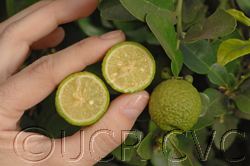Kingdom Plantae Family Rutaceae Subgenus Papeda | Order Sapindales Genus Citrus Rank Species | |
 | ||
Similar Citrus subg Papeda, Citrus latipes, Clymenia, Citrus ichangensis, Citrus macrophylla | ||
Citrus micrantha is a species of wild citrus of subgenus Papeda native to southern Philippines, particularly islands of Cebu and Bohol. Two varieties are recognized: small-flowered papeda (C. micrantha var. micrantha), locally known as biasong, and small-fruited papeda (C. micrantha var. microcarpa) or samuyao.
Contents
Citrus micrantha is thought to be one of the most primitive members of subgenus Papeda, which is the earliest branch of the Citrus genus. It is a progenitor species of lime. According to some sources, Citrus micrantha is likely a synonym of Citrus hystrix.
Description
Citrus micrantha was first described in 1915 by Peter Jansen Wester, who worked for the Philippine Bureau of Agriculture at the time.
Biasong
Wester collected ripe fruit specimens of biasong (small-flowered papeda, Citrus micrantha var. micrantha) on islands of Cebu, Bohol, Dumaguete, Negros, and in the Zamboanga and Misamis provinces in Mindanao. The fruits were collected throughout the year, indicating that the plant is ever-bearing. Biasong is characterized by small flowers (thus the "small-flowered" moniker) with fewer stamens than other papedas and oblong-obovate, few-loculed fruits. Inhabitants did not use the fruits for food, but for hair-washing, and it had little economic importance.
According to Wester's botanical description, biasong fruit aroma is similar to that of the samuyao. The tree reaches 7.5 to 9 meters in height. Leaves are 9–12 cm long, 2.7–4.0 cm wide, broadly elliptical to ovate, crenate, thin, with base rounded or broadly acute; apex acutely blunt pointed. Petioles are 3.5–6 cm long, broadly winged, up to 4 cm wide, with wings (phyllodes) sometimes larger than the leaf. Flowers are small, four-petaled, white with thin purple edge, 12–13 mm in diameter, forming cymes of two to five. There are 15–17 equal stamens. The ovary is obovoid, with 6–8 slender, distinct locules. Fruits are obovate to oblong-obovate, 5–7 cm long, with diameter of 3–4 cm, averaging 26 g in weight; their skin is rather thick, lemon-yellow, fairly smooth or with transverse corrugations; the pulp is juicy, grayish and acid, while juice cells are short and blunt to long, long, slender and pointed, sometimes containing a minute, greenish nucleus. They have numerous flat, pointed, reticulate seeds.
Samuyao
Wester collected ripe samuyao (small-fruited papeda, Citrus micrantha var. microcarpa) fruit specimens from cultivation in Cebu and Bohol in June, and from November to February. Samuyao is rather smaller than biasong, with tree attaining 4.5 meters. It has small, thin leaves and flowers comparable in size to biasong. The fruit, 15–20 mm in diameter, is likely to be the smallest in the whole genus. Wester also recorded a somewhat more vigorous variety, called "samuyao-sa-amoo" in Bohol, with slightly larger fruits; there is a possibility that this species was actually Limonellus aurarius, described by Georg Eberhard Rumphius back in 1741 in a nearby area, although his description also fits a number of related species. Wester gave the botanical description:
A shrubby tree, 4.5 meters tall, with slender branches and small, weak spines; leaves 55 to 80 millimeters long, 20 to 25 millimeters broad, ovate to ovate-oblong or elliptical, crenulate, thin, of distinct fragrance, base rounded to broadly acute; apex obtuse, sometimes notched, petioles 20 to 30 millimeters long, broadly winged, about 14 millimeters wide, wing area somewhat less than one-half of the leaf blade; flowers in compact axillary or terminal cymes, 2 to 7, small, 5 to 9 millimeters in diameter, white, with trace of purple on the outside; calyx small, not cupped, petals 3 to 5; stamens 15 to 18, free, equal; ovary very small, globose to obovate; locules 7 to 9, style distinct; stigma small, knob like; fruit 15 to 20 millimeters in diameter, roundish in outline; base sometimes nippled; apex an irregular, wrinkly cavity; surface corrugate, greenish lemon yellow; oil cells usually sunken; skin very thin; pulp fairly juicy, acid, bitter with distinct aroma; juice cells very minute, blunt, containing a small, greenish nucleus; seeds small, flattened, sometimes beaked.
Clear, intensely fragrant oil can be produced from the samuyao peel, with potential use in cosmetics, as evidenced by usage by local women as a hair fragrance.
